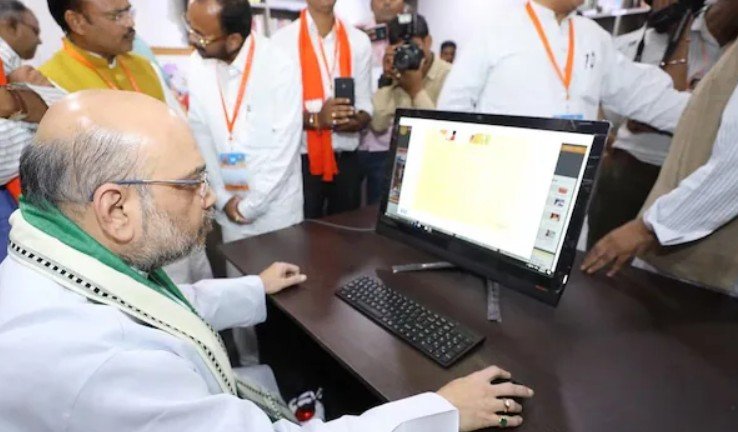The Swadeshi Tech Shift: How India’s Desi Startups Are Replacing Foreign Giants
ndia’s top ministers have switched to Zoho tools for communication, documentation, and collaboration. The move signals a major step toward digital sovereignty — but can the desi software truly replace global giants like Microsoft and Google?
In a move that could reshape India’s digital future, Union Home Minister Amit Shah and IT Minister Ashwini Vaishnaw have embraced Zoho Mail and Zoho Office Suite for official use. The Ministry of Education soon followed with a circular directing all departments to use Zoho tools instead of foreign software for documentation and communication.
This wave of government endorsements marks a strategic pivot toward indigenous technology under the Atmanirbhar Bharat and Digital India campaigns.
However, Zoho’s rise to official adoption has sparked both praise and scrutiny. Supporters see it as a step toward data sovereignty and economic self-reliance; critics warn about compatibility and scalability challenges.
This explainer breaks down why the government is backing Zoho, what it means for India’s SaaS industry, and how this shift could redefine digital governance.
What Is Zoho and Why It Matters
Founded in 1996 by Sridhar Vembu, Zoho Corporation is one of India’s earliest SaaS pioneers. With headquarters in Chennai and operations in over 180 countries, Zoho competes globally with Microsoft 365, Google Workspace, and Slack through a comprehensive suite of productivity and collaboration tools.
Key Zoho Tools Now in Government Use
| Tool | Function | Equivalent Foreign Software |
|---|---|---|
| Zoho Writer | Word processing | Microsoft Word |
| Zoho Sheet | Spreadsheets | Excel / Google Sheets |
| Zoho Show | Presentations | PowerPoint |
| Zoho Mail | Gmail / Outlook | |
| Zoho WorkDrive | Cloud storage | Google Drive / OneDrive |
The Government’s Swadeshi Tech Strategy
The decision to adopt Zoho aligns with Prime Minister Narendra Modi’s push for self-reliance in technology and manufacturing. It mirrors the larger policy framework of Digital India, focusing on data localization, cybersecurity, and reduction of foreign dependency.
IT Minister Ashwini Vaishnaw’s post on X in September 2025 sparked the movement:
“I am moving to Zoho… I urge all to join PM Narendra Modi’s call for swadeshi by adopting indigenous products and services.”
Shortly after, Education Minister Dharmendra Pradhan and senior officials across ministries endorsed Zoho’s tools. Even Zoho’s messaging app, Arattai, designed as a “Made in India” alternative to WhatsApp, saw renewed public attention.
Why the Shift: Core Drivers Behind the Decision
a. Data Security and Sovereignty
Government communications, files, and records will now be stored on servers within India, preventing exposure to international data laws like the U.S. CLOUD Act. This ensures data sovereignty — a critical concern for national security.
b. Cost Efficiency
Large-scale enterprise licensing from global companies costs the government crores annually. Zoho’s competitive pricing and volume-based licensing significantly reduce recurring software costs.
Insert Chart:
Visual: Bar graph comparing estimated annual costs for 100,000 government users
- Microsoft 365: ₹450 crore
- Google Workspace: ₹390 crore
- Zoho One Suite: ₹145 crore
Caption: Zoho offers nearly 60% cost savings for enterprise-scale usage.
c. Make in India and Atmanirbhar Bharat
By adopting Zoho, the government is endorsing Indian innovation and building confidence in homegrown solutions. This move parallels efforts to localize production in hardware and electronics.
d. Full Productivity Suite
Zoho’s unified ecosystem includes word processing, spreadsheets, presentations, email, CRM, and AI tools — eliminating the need for multiple external vendors.
e. AI Integration and Privacy
Zoho uses AI for workflow automation while ensuring end-to-end encryption. This balances efficiency with data privacy.
Industry and Political Reactions
Support from Indian Tech Circles
NASSCOM, India’s top IT industry body, hailed the decision as a “milestone in digital sovereignty.”
A senior cybersecurity consultant added,
“It’s not only about saving money — it’s about regaining control of India’s data.”
Resurgence of Arattai
Zoho’s messaging app, Arattai (“casual talk” in Tamil), launched quietly in 2021, suddenly surged to over 7.5 million downloads in October 2025 after ministerial endorsements. It climbed to #1 on Apple’s App Store India and broke into Google Play’s Top 100.
Public Skepticism
Critics question logistical feasibility and security uniformity.
“How can one ministry move to Zoho while others remain on Google or Microsoft? What about interoperability?” asked policy researcher Rishabh Mukherjee on X.
Such doubts highlight the operational challenges of a fragmented digital transition.
Timeline: How Zoho Became the Government’s Swadeshi Choice
2021
Launch of Arattai messaging app
2023
Zoho integrates AI across its productivity tools
June 2025
Rising U.S. tariffs renew calls for digital self-reliance
September 2025
Ashwini Vaishnaw announces switch to Zoho
October 2025
Ministry of Education mandates Zoho for official use
Ongoing
Amit Shah and key ministries adopt Zoho Mail
Zoho’s journey from a private SaaS firm to a government-backed platform mirrors India’s evolving digital policy.
Lessons from China’s Tech Model
China successfully built a self-contained digital ecosystem through Baidu, Tencent, and Alibaba. Analysts say India is now pursuing a balanced model—encouraging homegrown innovation while maintaining global connectivity.
The difference: India aims to compete globally, not isolate domestically. Zoho, already serving over 100 million users worldwide, exemplifies that global potential.
The Impact on India’s SaaS Ecosystem
The government’s endorsement of Zoho could reshape India’s software industry.
| Impact Area | Expected Outcome |
|---|---|
| Domestic SaaS Adoption | Surge in adoption by state and public institutions |
| R&D Investment | Increase in funding for Indian software innovation |
| Employment | More local software engineering jobs |
| Global Recognition | Boost to India’s brand as a software exporter |
| Startup Ecosystem | Inspiration for new Indian SaaS entrants |
India’s SaaS Hubs

Zoho’s success reinforces India’s emergence as a global SaaS powerhouse.
Challenges Ahead
- Training and Adaptation: Government staff will need retraining to transition from Microsoft or Google ecosystems.
- Compatibility: Cross-platform integration remains a challenge, especially for document sharing.
- Scalability: Zoho must ensure stable infrastructure for millions of concurrent users.
- Public Perception: Skeptics must be convinced that a domestic firm can meet enterprise-grade standards.
- Vendor Neutrality: Ensuring fair competition for other Indian tech firms will be crucial for a healthy digital ecosystem.
Conclusion: A Step Toward Digital Independence
India’s shift to Zoho is not just about software—it’s about sovereignty. In an age where digital infrastructure defines national strength, this decision signals a confident step toward self-reliant technology governance.
India’s Path to Digital Sovereignty
Government adoption of Zoho could triple domestic SaaS market share by 2027.
If the rollout succeeds, Zoho’s journey could become a template for digital self-reliance, inspiring other Indian firms and setting a global precedent for government adoption of indigenous SaaS platforms.
As the world debates data control and foreign dependence, India’s message is clear: Digital India must be built on Indian innovation


